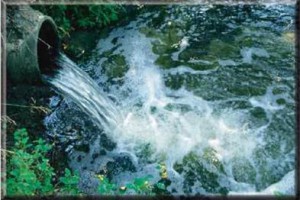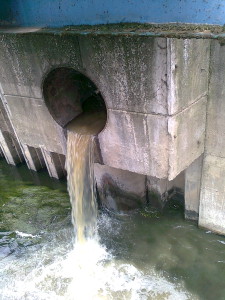
In many large cities in the world, combined sewer systems are generally used to evacuate wastewaters. In this sanitation system, during rainfall periods, domestic wastewaters and runoff waters are mixed in the combined sewers and the total discharge can overwhelm the transport capacity of the sewer network and/or the treatment capacity of the wastewater treatment plant (WWTP). When it is the case, a part of the discharge is released directly into the receiving surface waters without any treatment; this is called a combined sewer overflow (CSO). In urban areas, CSOs are known to be a major source of microbiological contamination responsible for the degradation of the receiving natural environments quality during rainy periods. In these conditions, it is important to improve our knowledge on the flux of microbial contaminants released by CSO’s and the impact of CSO’s on the microbiological quality of the receiving natural waters.

To achieve these goals, field studies are conducted in order to evaluate the temporal fluctuations of the microbiological quality (concentration of fecal indicator bacteria, FIB) in CSO’s and in rivers downstream from CSO’s. ESA has participated to such studies in the Parisian area where CSO are released in the Seine River and in the Brussels capital region where CSO are released in the Zenne River. In addition, ESA has collaborated with a team of Polytechnic School of Montréal to study CSO’s in the Montréal area.
Partners:
UMR Métis – Université Pierre et Marie Curie (Mouchel, J.M.), LEESU – Université Paris Val de Marne (Lucas, F.), SIAAP – Syndicat Interdépartemental d’Assainissement de l’Agglomération Parisienne (Rocher, V.) – Ecole Polytechnique de Montréal (Dorner, S., Prévost, M.)
ESA members participating to this study:
Servais, P., Passerat, J., Ouattara, K.
Period of the study:
January 2007- December 2017.
Financial support:
PIREN Seine Program (http://www.sisyphe.upmc.fr/piren/)
innoviris
Publications:
Lucas, F. Thérial, C., Goncalves, A., Servais, P., Rocher, V. & Mouchel, J.M. 2014. Variation of raw wastewater microbiological quality in dry and wet weather conditions. Environmental Science and Pollution Research. 21:5318–5328.
Lucas, F., Goncalves, A., Servais, P., Rocher, V., Masnada, S., Thérial, C. Lesage, L., Mouchel, J.M. 2012. Variabilité de la qualité microbiologique des eaux usées brutes dans une grande agglomération. Techniques, Sciences, Méthodes. 2012. 4: 44-55.
Passerat, J. Ouattara, K., Mouchel, J.M., Rocher, V. and Servais, P. 2011. Impact of an intense combined sewer overflow event on the microbiological water quality of the Seine River. Water Research. 45 : 893-903.
Ouattara, N.K., Garcia-Armisen, T., Anzil, A., Brion, N. & Servais, P. 2014. Impact of wastewater release on the faecal contamination of a small urban river: the Zenne River in Brussels (Belgium). Water, Air, Soil pollution. 225 (8) : 2043
Madoux-Humery, A.S., Dorner, S., Sauvé, S., Aboulfadi, K., Galarneau, M., Servais, P. & Prévost, M. 2016. The effects of combined sewer overflow events on riverine sources of drinking water. Water Research. 92. 218-227.
Madoux-Humery, A.S., Dorner, S., Sauvé, S., Aboulfadi, K., Galarneau, M., Servais, P. & Prévost, M. 2015. Temporal analysis of E. coli, TSS and wastewater micropollutant loads from combined sewer overflows: implications for management. Environ. Sci. Processes Impacts. 17: 965-974.
Madoux-Humery, A.S., Dorner, S., Sauvé, S., Aboulfadi, K., Galarneau, M., Servais, P. & Prévost, M. 2013. Temporal variability of Combines Sewer Overflows contaminants: evaluation of Wastewater Micropollutants as tracers of fecal contamination. Water Research. 47: 4370-4382.
